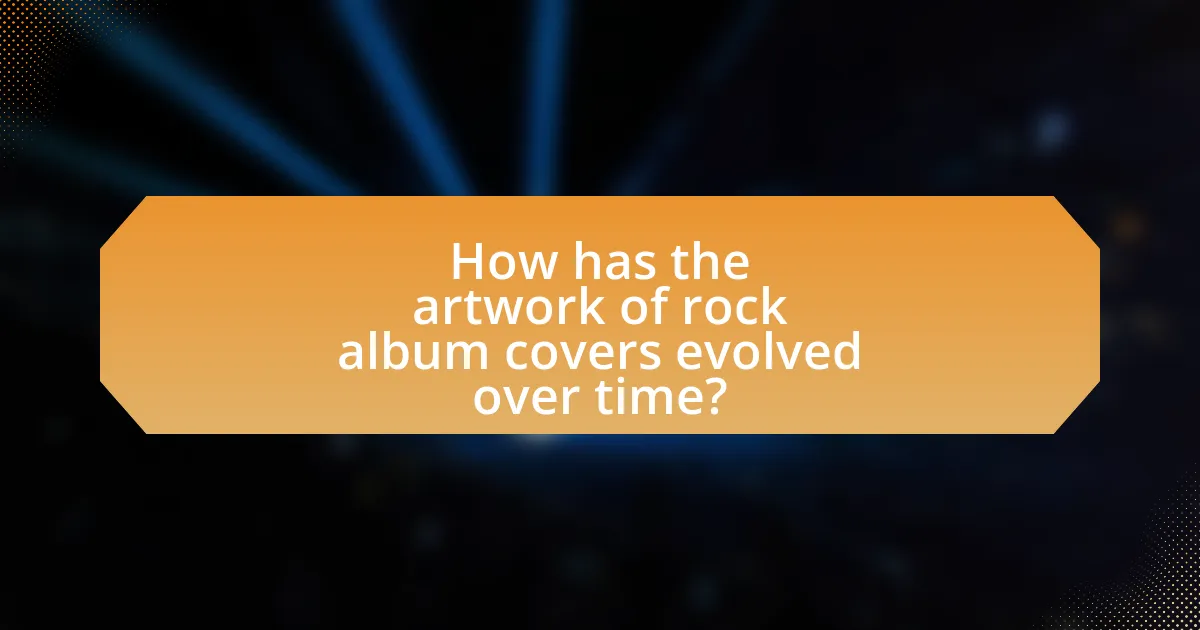The article analyzes the artwork of iconic rock album covers, focusing on how visual elements, colors, typography, and cultural context contribute to their significance. It highlights notable examples such as Pink Floyd’s “The Dark Side of the Moon” and The Beatles’ “Sgt. Pepper’s Lonely Hearts Club Band,” examining the impact of artist collaborations and technological advancements on album design. Additionally, the article discusses the evolution of album artwork over time, key trends in design, and the influence of different rock subgenres, providing insights for emerging artists on best practices in creating compelling album visuals.
![]()
What defines iconic rock album covers?
Iconic rock album covers are defined by their ability to visually encapsulate the essence of the music and the cultural context of the time. These covers often feature striking imagery, innovative design, and a strong connection to the themes of the album, making them memorable and influential. For example, the cover of Pink Floyd’s “The Dark Side of the Moon” uses a simple yet powerful prism design to symbolize the complexity of human experience, which resonates deeply with the album’s themes. Additionally, covers like The Beatles’ “Sgt. Pepper’s Lonely Hearts Club Band” showcase vibrant colors and eclectic imagery that reflect the psychedelic era of the 1960s, further solidifying their iconic status. The combination of artistic creativity, cultural relevance, and emotional impact defines what makes these album covers iconic in the rock genre.
How do visual elements contribute to the identity of rock album covers?
Visual elements significantly contribute to the identity of rock album covers by establishing a distinct aesthetic that reflects the genre’s themes and cultural context. Iconic imagery, such as bold colors, striking typography, and symbolic graphics, creates an immediate visual association with the music and the artist’s persona. For instance, the cover of Pink Floyd’s “The Dark Side of the Moon” uses a prism to symbolize the band’s exploration of complex themes, while the artwork of The Rolling Stones’ “Sticky Fingers” features a working zipper, representing the raw and provocative nature of rock music. These visual choices not only enhance the album’s appeal but also communicate the underlying messages and emotions of the music, making the artwork an integral part of the rock identity.
What role do colors play in the perception of album artwork?
Colors significantly influence the perception of album artwork by evoking emotions and setting the tone for the music. For instance, warm colors like red and orange can create feelings of excitement or passion, while cool colors such as blue and green often convey calmness or melancholy. Research indicates that color psychology plays a crucial role in consumer behavior, with studies showing that 85% of consumers make purchasing decisions based on color alone. This demonstrates that the choice of colors in album artwork can directly impact listeners’ expectations and emotional responses to the music, ultimately affecting their overall experience.
How do typography choices impact the overall design?
Typography choices significantly impact the overall design by influencing readability, emotional tone, and brand identity. For instance, a bold, sans-serif font can convey modernity and strength, while a delicate serif font may evoke tradition and elegance. Research indicates that 95% of a message is retained when the typography aligns with the intended emotional response, as shown in studies by the Journal of Visual Communication. Additionally, typography can guide the viewer’s eye and create a hierarchy of information, enhancing the overall aesthetic and functional effectiveness of the design.
Why are certain album covers considered iconic?
Certain album covers are considered iconic due to their unique visual representation that resonates with cultural movements and musical themes. For example, the cover of The Beatles’ “Sgt. Pepper’s Lonely Hearts Club Band” is iconic because it reflects the psychedelic era of the 1960s and features a collage of influential figures, making a bold statement about art and music’s intersection. Additionally, the cover art of Pink Floyd’s “The Dark Side of the Moon” is recognized for its simple yet powerful prism design, symbolizing the complexity of human experience, which has become a universal emblem of rock music. These covers not only capture the essence of the albums but also influence popular culture, making them memorable and significant in the history of music.
What cultural or historical factors influence the iconic status of album covers?
Cultural and historical factors significantly influence the iconic status of album covers by shaping their visual representation and societal reception. The rise of counterculture movements in the 1960s, such as the hippie movement, led to album covers that reflected themes of rebellion, peace, and psychedelic art, exemplified by the Beatles’ “Sgt. Pepper’s Lonely Hearts Club Band,” which became a cultural touchstone. Additionally, the evolution of graphic design and technology, including the introduction of photography and digital art, allowed for more innovative and expressive album artwork, as seen in Pink Floyd’s “The Dark Side of the Moon,” which utilized striking imagery to convey complex themes. Furthermore, the impact of music genres, such as punk rock’s DIY ethos, influenced album cover aesthetics, making them symbols of identity and cultural movements. These factors collectively contribute to the enduring iconic status of album covers in music history.
How do artist collaborations shape the artwork of rock albums?
Artist collaborations significantly shape the artwork of rock albums by merging diverse creative visions and styles, resulting in unique visual representations. For instance, the collaboration between artist Storm Thorgerson and the band Pink Floyd produced iconic covers like “The Dark Side of the Moon,” which combined surreal imagery with thematic depth, enhancing the album’s conceptual narrative. Such partnerships often lead to innovative designs that reflect the music’s essence, as seen in the collaboration between artist Roger Dean and the band Yes, where fantastical landscapes became synonymous with their sound. These collaborations not only elevate the aesthetic appeal but also create a lasting cultural impact, as evidenced by the enduring recognition of these artworks in popular culture.

How has the artwork of rock album covers evolved over time?
The artwork of rock album covers has evolved significantly from the 1960s to the present day, reflecting changes in artistic styles, technology, and cultural trends. Initially, album covers featured simple designs and photographs, often focusing on the band members, as seen in The Beatles’ “Please Please Me” (1963). As the genre matured, artists began to experiment with more abstract and conceptual designs, exemplified by Pink Floyd’s “The Dark Side of the Moon” (1973), which utilized innovative graphics and symbolism.
The introduction of digital technology in the 1990s further transformed album artwork, allowing for more intricate designs and the use of computer-generated imagery, as demonstrated in Radiohead’s “OK Computer” (1997). In recent years, the rise of streaming services has shifted the focus from physical album covers to digital representations, yet artists continue to create visually striking artwork to maintain their identity, as seen in Billie Eilish’s “When We All Fall Asleep, Where Do We Go?” (2019). This evolution illustrates how rock album cover art has adapted to technological advancements and changing consumer behaviors while still serving as a vital form of artistic expression.
What are the key trends in rock album cover design through the decades?
Key trends in rock album cover design through the decades include the evolution from simple typography in the 1960s to elaborate artwork and photography in the 1970s, the rise of conceptual and surreal designs in the 1980s, and the shift towards minimalism and digital art in the 1990s and 2000s. In the 1960s, iconic covers like The Beatles’ “Sgt. Pepper’s Lonely Hearts Club Band” showcased vibrant colors and intricate illustrations, reflecting the psychedelic movement. The 1970s saw bands like Pink Floyd use striking imagery, as seen in “The Dark Side of the Moon,” emphasizing thematic depth. The 1980s introduced bold graphics and conceptual art, exemplified by albums like David Bowie’s “Let’s Dance.” In the 1990s and 2000s, the advent of digital technology led to minimalist designs, such as Radiohead’s “OK Computer,” which focused on stark visuals and abstract concepts. Each decade’s trends reflect broader cultural movements and technological advancements in art and design.
How did the 1960s and 1970s influence modern album artwork?
The 1960s and 1970s significantly influenced modern album artwork by introducing innovative design concepts and a focus on visual storytelling. During this period, artists like The Beatles and Pink Floyd collaborated with graphic designers, leading to iconic covers such as “Sgt. Pepper’s Lonely Hearts Club Band” and “The Dark Side of the Moon,” which emphasized artistic expression and thematic depth. This era also saw the rise of photography and collage techniques, which are now staples in contemporary album design. The emphasis on creating a cohesive visual identity for music, as seen in the works of artists like Andy Warhol and Robert Frank, laid the groundwork for modern album covers that prioritize aesthetic appeal and cultural commentary.
What technological advancements have impacted album cover design?
Technological advancements such as digital imaging, graphic design software, and printing technology have significantly impacted album cover design. Digital imaging allows for high-resolution graphics and intricate designs that were previously impossible with traditional methods. Graphic design software like Adobe Photoshop and Illustrator enables artists to create complex visuals and manipulate images easily, enhancing creativity and precision. Additionally, advancements in printing technology, including digital printing and high-quality color reproduction, have improved the physical production of album covers, allowing for vibrant colors and detailed artwork. These innovations have transformed the way album covers are conceptualized, designed, and produced, making them an integral part of music marketing and artistic expression.
How do different genres within rock influence album cover art?
Different genres within rock significantly influence album cover art by dictating visual themes, color palettes, and stylistic elements that reflect the music’s identity. For instance, punk rock often features raw, DIY aesthetics with bold graphics and provocative imagery, exemplified by the Sex Pistols’ “Never Mind the Bollocks,” which uses bright colors and stark typography to convey rebellion. In contrast, progressive rock tends to embrace intricate and surreal artwork, as seen in Pink Floyd’s “The Dark Side of the Moon,” where the prism symbolizes complexity and depth, aligning with the genre’s elaborate musical compositions. Additionally, heavy metal album covers frequently showcase dark, fantastical imagery, such as Iron Maiden’s “The Number of the Beast,” which employs gothic elements to resonate with the genre’s themes of power and darkness. These genre-specific characteristics in album cover art serve not only as visual representations of the music but also as marketing tools that attract the target audience, reinforcing the connection between the sound and its visual counterpart.
What distinguishes punk rock album covers from classic rock covers?
Punk rock album covers are distinguished from classic rock covers primarily by their raw, DIY aesthetic and often provocative imagery. While classic rock covers typically feature polished designs and elaborate artwork that reflect mainstream appeal, punk rock covers embrace a more chaotic and rebellious style, often utilizing collage techniques, hand-drawn elements, and stark color contrasts. For example, the cover of the Sex Pistols’ “Never Mind the Bollocks” showcases bold typography and a simple, yet striking design that conveys a sense of urgency and defiance, contrasting sharply with the intricate and stylized artwork found on albums like Pink Floyd’s “The Dark Side of the Moon.” This divergence in artistic approach reflects the differing cultural attitudes of the two genres, with punk rock prioritizing anti-establishment themes and authenticity over commercial polish.
How do subgenres like metal or indie rock approach album artwork differently?
Metal and indie rock approach album artwork differently in terms of themes and visual styles. Metal album artwork often features dark, aggressive imagery, including fantasy elements, horror motifs, and intricate illustrations that reflect the intensity of the music. For example, iconic metal albums like Iron Maiden’s “The Number of the Beast” showcase detailed artwork that complements the lyrical themes of fear and rebellion. In contrast, indie rock album artwork tends to embrace a more minimalist and artistic aesthetic, often using photography, abstract designs, or hand-drawn illustrations that convey a sense of authenticity and personal expression. An example is the album “In the Aeroplane Over the Sea” by Neutral Milk Hotel, which features a whimsical cover that aligns with its introspective and emotional content. This distinction highlights how each subgenre uses visual art to enhance its musical identity and connect with its audience.
![]()
What are the most notable examples of iconic rock album covers?
The most notable examples of iconic rock album covers include “The Dark Side of the Moon” by Pink Floyd, “Abbey Road” by The Beatles, and “Led Zeppelin IV” by Led Zeppelin. “The Dark Side of the Moon,” released in 1973, features a prism dispersing light, symbolizing the album’s exploration of themes like time and mental health, and it has become one of the best-selling albums of all time, with over 45 million copies sold globally. “Abbey Road,” released in 1969, showcases the famous zebra crossing outside Abbey Road Studios and is often regarded as a cultural landmark, influencing countless artists and becoming a symbol of the 1960s. “Led Zeppelin IV,” released in 1971, features a mysterious artwork with a rustic painting and no title, which has sparked extensive discussion about its meaning and has contributed to the album’s status as one of the greatest rock albums, selling over 37 million copies worldwide.
Which album covers are frequently cited as the most influential?
The album covers frequently cited as the most influential include The Beatles’ “Sgt. Pepper’s Lonely Hearts Club Band,” Pink Floyd’s “The Dark Side of the Moon,” and Nirvana’s “Nevermind.” “Sgt. Pepper’s” is renowned for its vibrant colors and innovative design, which set a new standard for album artwork in the 1960s. “The Dark Side of the Moon” features a simple yet iconic prism design that has become synonymous with the band and is recognized for its artistic and conceptual depth. “Nevermind” is notable for its striking imagery of a baby swimming towards a dollar bill, which captured the essence of the 1990s grunge movement. These covers have not only defined their respective albums but have also influenced countless artists and designers in the music industry.
What makes “The Dark Side of the Moon” cover a classic?
The cover of “The Dark Side of the Moon” is considered a classic due to its iconic prism design, which symbolizes the spectrum of light and the complexity of human experience. Created by the design group Hipgnosis, the artwork effectively captures the album’s themes of mental health, time, and existentialism. The use of simple yet powerful imagery, combined with the innovative use of color, has made it one of the most recognizable album covers in music history, contributing to its lasting impact and cultural significance.
How did “Nevermind” redefine expectations for album artwork?
“Nevermind” redefined expectations for album artwork by featuring a striking and provocative image that challenged conventional aesthetics in the music industry. The cover, depicting a naked baby swimming towards a dollar bill on a fishhook, captured attention and sparked discussions about themes of innocence, capitalism, and societal critique. This bold visual choice contrasted sharply with the typical album covers of the early 1990s, which often relied on polished imagery or band portraits. The artwork’s impact was significant, contributing to the album’s commercial success and cultural relevance, as it became emblematic of the grunge movement and a symbol of a generation’s disillusionment.
What lessons can be learned from analyzing these iconic covers?
Analyzing iconic rock album covers reveals lessons about visual storytelling, cultural impact, and branding. These covers often encapsulate the essence of the music and the artist’s identity, using imagery to evoke emotions and convey messages. For instance, The Beatles’ “Sgt. Pepper’s Lonely Hearts Club Band” cover employs vibrant colors and a collage of figures to reflect the psychedelic era and the band’s innovative spirit. This demonstrates how visual elements can enhance the listener’s experience and create a lasting impression. Additionally, covers like Pink Floyd’s “The Dark Side of the Moon” illustrate the power of minimalist design, where a simple prism symbolizes complex themes of life and existence. Such analysis underscores the importance of creativity and conceptual depth in visual art, influencing both the music industry and popular culture.
How can emerging artists apply these insights to their own album designs?
Emerging artists can apply insights from iconic rock album covers by focusing on strong visual storytelling, unique typography, and cohesive color schemes. These elements are crucial as they create an immediate emotional connection with the audience, enhancing the overall impact of the album. For instance, the use of bold imagery in covers like Pink Floyd’s “The Dark Side of the Moon” not only reflects the album’s themes but also establishes a memorable brand identity. Additionally, artists should consider the historical context and cultural significance of their designs, as seen in The Beatles’ “Sgt. Pepper’s Lonely Hearts Club Band,” which utilized vibrant colors and eclectic imagery to capture the spirit of the 1960s. By integrating these strategies, emerging artists can create compelling album designs that resonate with listeners and stand out in a competitive market.
What best practices should be followed when creating album artwork?
When creating album artwork, it is essential to ensure that the design reflects the music’s genre and themes. This alignment enhances the listener’s connection to the album. Additionally, using high-resolution images is crucial, as this ensures clarity and professionalism in both digital and physical formats. Incorporating unique and memorable visuals can help the artwork stand out in a crowded market, which is supported by the fact that iconic album covers often become synonymous with the music itself, such as The Beatles’ “Sgt. Pepper’s Lonely Hearts Club Band.” Furthermore, considering the target audience’s preferences can guide the design choices, making the artwork more appealing and relevant. Lastly, maintaining a cohesive visual identity across all promotional materials strengthens brand recognition, as seen with artists like David Bowie, whose album covers consistently reflected his evolving persona.


